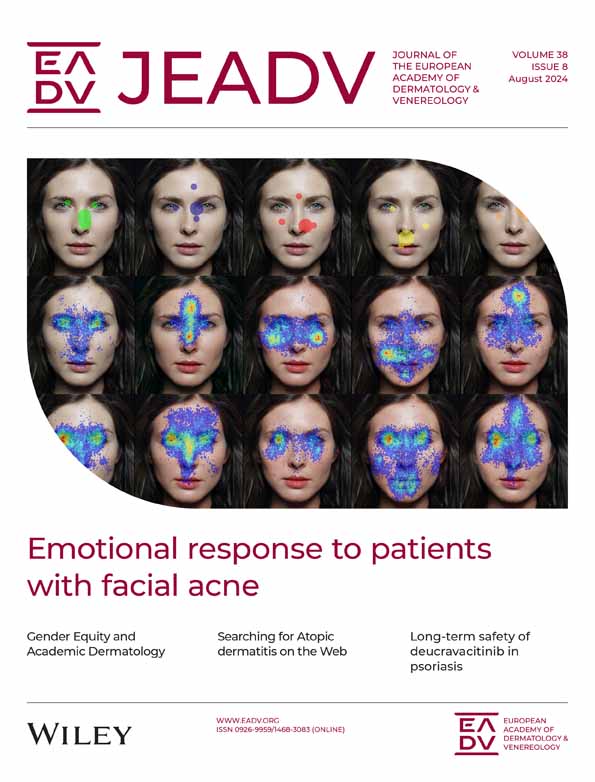Decoding tumour-immune dynamics in melanomas arising on congenital melanocytic nevi
Linked article: Y. Lim et al. J Eur Acad Dermatol Venereol 2024;38:1599–1605. https://doi.org/10.1111/jdv.19881.
Congenital nevi are rare melanocytic proliferations that are present at birth or appear before the second year of life. These lesions differ from acquired nevi in several ways: not only do they exhibit different clinical and dermoscopic characteristics but they also express different types of mutations, including mutations in c-kit and NRAS pathways. Additionally, giant congenital nevi can be characterized by NRAS mosaicism in up to 70%–80% of cases with melanocytic cells able to demonstrate potential for sporadic evolution. This type of heterogeneity can expand to the expression of genes associated to antigen presentation and processing. These observations should not be surprising as recent data have shown that the prognosis of cutaneous melanoma also depends in its complex interactions with its environment, the immune system and the extracellular matrix and all its components.
The paper by Lim et al. attempts to describe the interactions between tumour cells and the immune system. Tissue specimens were received by two adult patients with melanoma arising on congenital nevi and gene expression in both melanoma cells and tumour infiltrating immune cells (TIICs) was investigated.1 The findings of this study demonstrated that in deeply invaded areas, CXCL9 and CXCL10 expression was decreased, while LGALS3 expression was increased. The CXCL9/CXCL10/CXCR3 axis has been shown to promote tumour suppression and immune system activation through a paracrine axis2 while LGALS3 is able to cause immunosuppression by skewing macrophage polarization towards the M2 phenotype, the apoptosis of cytotoxic T lymphocytes and downregulation of T-cell receptor expression. Tumour-associated macrophages (TAMs) have been thoroughly investigated in melanoma and have been shown to be able to oscillate between M1 and M2 phenotypes depending on the tumour microenvironment conditions. In addition, M2 TAMs seem to be the prevailing phenotype in more advanced tumours, while the M1/M2 ratio has been described to have a prognostic significance. LGALS3 expression is not only associated with the regulation of Treg populations but has also been strongly linked with metastatic disease. Interestingly, the expression of extracellular and intracellular LGALS3 may have distinct effects on melanoma progression. Extracellular LGALS3 is a pleiotropic promoter of melanoma metastasis while intracellular expression of LGALS3 is downregulated in metastatic melanoma. Loss of intracellular LGALS3 has also been associated with NFAT1 upregulation as well as promotion of cellular migration and invasion. Although these findings may seem contradictory at first glance, they are not surprising given the extremely complicated interactions between melanoma and its microenvironment.3 BST2, AXL and EPHA2 were found to be upregulated in metastatic lesions. BST2 is a pyroptosis gene, whose expression has been shown to be negatively correlated with patient survival. Although its full role is still being investigated in cutaneous melanoma (M2 polarization, melanocyte development, pigment formation), BST2-associated monoclonal antibodies have been researched for the treatment of multiple myeloma. AXL is a gene that encodes a tyrosine kinase receptor able to regulate cell proliferation, cell migration and regulation of immune responses. AXL inhibition (blocking receptor autophosphorylation) has been shown to improve BRAF-targeted treatment results suggesting a possible role as a therapeutic target.4 EPHA2 is another gene whose upregulation has been associated with melanoma metastasis and treatment resistance and whose therapeutic targeting has been attempted.
When gene expression in T cells was investigated, it was found that several genes associated with T-cell activation and tumour infiltration were downregulated, while genes involved in T-cell inhibition were upregulated. ADGRG1, associated with T-cell exhaustion, was also upregulated in metastatic lesions. Additionally, genes associated with the M2 macrophage phenotype were upregulated. CCR4 expression in melanoma has been associated with brain metastasis; however, limited information exists in regards to its expression in TIICS. A recent paper showed that CD4+ T-cell metaclusters consisting of CXCR3+CCR4−CCR6+ and CXCR3−CCR4−CCR6+ cells were characterized by high expression of IL7 receptor and TCF7 and their presence in peripheral blood of patients with lung cancer was associated with a higher progression-free survival interval. GZMK/B, associated with CD8+ T-cell activation, as well as CCL4, GNLY and NKG7 expression was reported in responders to immunotherapy.5
Data on the characteristics of CMN melanomas and their microenvironment are very important. This paper has suggested that gene expression associated with immune evasion, migration and survival is similar between CMN melanomas and other cutaneous melanomas. These findings, besides the characterization of tumours, can allow for discovering new therapeutic targets and biomarkers for tumour prognosis and treatment success. Additionally, it can pave the way for more robust data on the treatment approaches for paediatric melanoma patients.
FUNDING INFORMATION
None declared.
CONFLICT OF INTEREST STATEMENT
The authors declare no conflicts of interest.
Open Research
DATA AVAILABILITY STATEMENT
Data sharing not applicable to this article as no datasets were generated or analysed during the current study.




